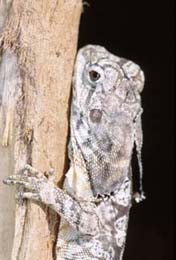|
|
|
"Fearless forest forager" |
|
For
as small as the frilled necks appear, they are almost exclusively
carnivorous. They will feed primarily on small invertebrates and have
been known to feed on small mammals. Among some of their favorite foods are
the green ant, the larva of butterflies, moths, and various other
insects.
The frilled neck is classified as a forager, which means they generally donít go after moving food. Normally the frilled neck will stay in the tree and wait for their food to come to them. They mostly feed on the insects found on the trees where they are perched. Occasionally the frilled neck will leave its perch to go after its food. They will come down from their perch and proceed to run after their prey. The frilled neck is quite a fast runner. When running, the frill neck becomes biped. When they get closer to their prey, the frilled neck will run on all fours. After the frill neck catches and swallows its prey whole, it will return to its perch to digest. The frilled neck has: a stomach where there are a lot of acids to help break down the whole food, intestines with many folds to increase surface area and allow the large mass of food to pass through, as well as a liver which makes the enzymes to break down the food. The frilled neck will forage much more during the rainy season when food is more prevalent. The rainy season also brings about mating season. To learn more about the mating habits of the frilled necks, follow me to reproduction! |
|
Send comments about this page to Kim Acker |
-











